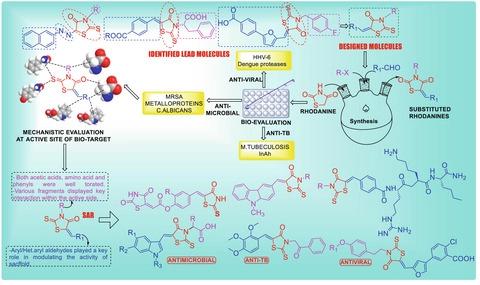当前位置:
X-MOL 学术
›
Chem. Bio. Drug Des.
›
论文详情
Our official English website, www.x-mol.net, welcomes your feedback! (Note: you will need to create a separate account there.)
Rhodanine derivatives: An insight into the synthetic and medicinal perspectives as antimicrobial and antiviral agents
Chemical Biology & Drug Design ( IF 3.2 ) Pub Date : 2022-11-29 , DOI: 10.1111/cbdd.14163 Abhishek Chaurasyia 1 , Pooja Chawla 1 , Vikramdeep Monga 2 , Gurpreet Singh 1, 3
Chemical Biology & Drug Design ( IF 3.2 ) Pub Date : 2022-11-29 , DOI: 10.1111/cbdd.14163 Abhishek Chaurasyia 1 , Pooja Chawla 1 , Vikramdeep Monga 2 , Gurpreet Singh 1, 3
Affiliation

|
Rhodanine or 2-Thioxothiazolidin-4-one is a privileged heterocyclic compound offering a wide opportunity for structural modification, lead development, and modification. It is one of the highly decorated scaffolds in the drug discovery process. Rhodanine derivatives possess a plethora of biological activities due to their ability to interact with a diverse range of protein targets, which provide tremendous opportunities to discover new drugs with different modes of action. The most common strategy for developing novel rhodanine derivatives is the introduction of structurally diverse substituents at the C-5 or N-3, or both positions. Since the inception of Epralestat into the market in 1992, the exploration of rhodanine-3-acetic acids has led to the development of novel leads against different biological targets such as MRSA, HHV-6, Mycobacterial tuberculosis, dengue, etc. In the current pandemic era, some rhodanine compounds have been explored against SARS-CoV-2. In recent years, rhodanine and its derivatives have witnessed significant progress in developing new drug leads as potential antimicrobial and antiviral agents. Different synthetic methodologies and recent developments in the medicinal chemistry of rhodanine derivatives, including biological activities, their mechanistic aspects, structure–activity relationships, and in silico findings, have been compiled in the present review. This article will benefit the scientific community and offer perspectives on how these scaffolds as privileged structures might be exploited in the future for rational design and discovery of rhodanine-based bio-active molecules.
中文翻译:

罗丹宁衍生物:深入了解作为抗菌剂和抗病毒剂的合成和医学前景
罗丹宁或 2-Thioxothiazolidin-4-one 是一种特殊的杂环化合物,为结构修饰、先导化合物开发和修饰提供了广泛的机会。它是药物发现过程中高度装饰的支架之一。罗丹宁衍生物由于能够与多种蛋白质靶标相互作用而具有多种生物活性,这为发现具有不同作用模式的新药提供了巨大的机会。开发新型罗丹宁衍生物的最常见策略是在 C-5 或 N-3 或两个位置引入结构多样的取代基。自 1992 年 Epralestat 进入市场以来,对罗丹宁-3-乙酸的探索导致针对不同生物靶标(如 MRSA、HHV-6、结核分枝杆菌、登革热等。在当前的大流行时代,一些罗丹宁化合物已被探索用于对抗 SARS-CoV-2。近年来,罗丹宁及其衍生物在开发作为潜在抗菌剂和抗病毒剂的新药先导方面取得了重大进展。本综述汇总了罗丹宁衍生物的不同合成方法和药物化学的最新发展,包括生物活性、它们的机理方面、构效关系和计算机发现。本文将使科学界受益,并就未来如何利用这些支架作为特权结构来合理设计和发现基于罗丹宁的生物活性分子提供观点。
更新日期:2022-11-29
中文翻译:

罗丹宁衍生物:深入了解作为抗菌剂和抗病毒剂的合成和医学前景
罗丹宁或 2-Thioxothiazolidin-4-one 是一种特殊的杂环化合物,为结构修饰、先导化合物开发和修饰提供了广泛的机会。它是药物发现过程中高度装饰的支架之一。罗丹宁衍生物由于能够与多种蛋白质靶标相互作用而具有多种生物活性,这为发现具有不同作用模式的新药提供了巨大的机会。开发新型罗丹宁衍生物的最常见策略是在 C-5 或 N-3 或两个位置引入结构多样的取代基。自 1992 年 Epralestat 进入市场以来,对罗丹宁-3-乙酸的探索导致针对不同生物靶标(如 MRSA、HHV-6、结核分枝杆菌、登革热等。在当前的大流行时代,一些罗丹宁化合物已被探索用于对抗 SARS-CoV-2。近年来,罗丹宁及其衍生物在开发作为潜在抗菌剂和抗病毒剂的新药先导方面取得了重大进展。本综述汇总了罗丹宁衍生物的不同合成方法和药物化学的最新发展,包括生物活性、它们的机理方面、构效关系和计算机发现。本文将使科学界受益,并就未来如何利用这些支架作为特权结构来合理设计和发现基于罗丹宁的生物活性分子提供观点。











































 京公网安备 11010802027423号
京公网安备 11010802027423号